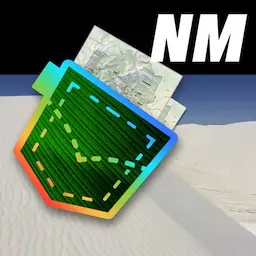"Chetro Ketl great kiva" by U.S. National Park Service , public domain
Pre-Columbian Chocolate Discovered at ChacoChaco Culture |
featured in
| National Parks Pocket Maps |  | |
| New Mexico Pocket Maps |  |
Chaco Culture
National Historical Park
National Park Service
U.S. Department of the Interior
Pre-Columbian Chocolate Discovered at Chaco
Dr. Patricia Crown examining a
cylinder jar, photo courtesy of
UNM Today.
Though the National Park Service rarely sponsors archaeological excavations
today, archaeologists and other researchers are still learning new things from the
material remains of ancestral Puebloan culture all the time. Technologies like
LiDAR photography (an optical remote sensing technology) and ground
penetrating radar give us new eyes on the resources at Chaco. Very recently
evidence of cacao (chocolate!) was
discovered in cylinder jars, a pottery style
found almost exclusively in Pueblo
Bonito, using a tiny sample of ground
pottery sherd. The process is called
organic residue analysis.
In the late 1800s Richard Wetherill and his
assistant George Pepper, the first archaeologists to work in Chaco, excavated
111 cylinder jars from one particular room at Pueblo Bonito. These men knew
they had found something special, though they could not have imagined what
we would learn from the jars more than 100 years later. Over the course of
subsequent excavations, archaeologists have gained a deeper understanding of
just how unique these vessels are. Fewer than 200 have been found in the
entire American Southwest, including those in Room 28 at Pueblo Bonito.
Scholars have long known that a drink made from cacao was consumed in
Roasted cacao bean, photo courtesy
of Sifu Renka.
ancient Mesoamerica. Some Maya cylinder jars even incorporate paintings of
the precious liquid being poured for rulers and gods, though average people
sometimes consumed it as well. The Maya ground
the beans; mixed them with spices, chilies, and
water; and frothed the drink for consumption either
hot or cold.
Most of the jars found in the famous cache at Pueblo
Bonito are more than twice as tall as they are wide
and painted with black designs on a white
background. Because of their distinct shape and
exclusive locations, archaeologists have typically
agreed that they were used ritually. Ideas about their
use include that they were storage for turquoise or
prayer sticks, or that animal skins were stretched
over them to create drums. Almost all of these jars
are housed today in the American Museum of
Natural History in New York City, making
prolonged study logistically difficult.
Cylinder jars from Pueblo Bonito, photo courtesy of the American
Museum of Natural History.
From 2004-2007 a University of New Mexico (UNM) research project re-excavated the trenches first dug in Pueblo
Bonito’s middens under Neil Judd in the 1920s. Of the hundreds of thousands of pot sherds that were recovered,
archaeologist Patricia Crown selected five for her research. She is a
ceramics specialist at UNM’s Department of Anthropology. She designed
the project, and W. Jeffrey Hurst from The Hershey Center for Health and
Nutrition performed the research. They chose five pot sherds for organic
residue analysis, three of which were likely from cylinder jars. The pieces
date to between 1000 and 1125 AD based on their decorative styles.
Only the three sherds most likely from cylinder jars exhibited trace
theobromine, a conclusive indicator of cacao or chocolate. The implications
of this find are extraordinary. The cacao plant grows only in certain tropical
climates, and the nearest possibility for Chaco is Central Mexico. We
already know the Chacoan people traded with Mesoamerican cultures for
exotics like copper bells and Scarlet Macaws, but cacao suggests a more
ritual connection than other Mesoamerican goods. In some Maya
ceremonies a cacao beverage was frothed by pouring the liquid from one
vessel to another. Likewise, the cacao found at Chaco was probably in
liquid form because the residue had absorbed into the clay itself. Further,
the limited distribution of the cylinder jars could be evidence that only an
elite or small segment of the population consumed the beverage.
Jar from Central Maya area with cacao
glyph, photo courtesy of Mary Harrsch.
Today nearly every visitor to Chaco leaves the park remembering
Pueblo Bonito because of its size and level of preservation and
excavation. Perhaps the building had special importance in the Chacoan
world as well. So far, all indication of precious chocolate has been
associated with that site.
Excavations at Pueblo Bonito in 2007, NPS photo
In a few years we may have yet another picture of trade and ritual
activity in the ancient Southwest. Crown and Hurst recently received a
National Science Foundation (NSF) grant to test 300 more pieces of
pottery for theobromine. Not only are they expanding the sample size
of cylinder jars to include those in the American Museum, but they are
broadening their geographic scope. The researchers are testing
distinctive pottery representing the Mogollon and Hohokam cultures as
well.
Research today looks very different than it did under Wetherill and the early pioneers of archaeological inquiry, and
no one knows what future, less-destructive technologies will allow us to discover. Crown’s research is a dramatic
example of a lesson most visitors to Chaco already grasp: one artifact, left in place, can tell us volumes about the
people who made it.
Reference: Crown, Patricia and W. Jeffrey Hurst (2009) “Evidence of cacao use in the Prehispanic American
Southwest” from Proceedings of the National Academy of the Sciences of the United States of America (Department
of Anthropology, University of New Mexico and The Hershey Center for Health and Nutrition, Hershey, PA).
Rev January 2011
E X P E R I E N CE Y O U R AM E R I C A


